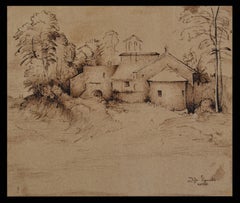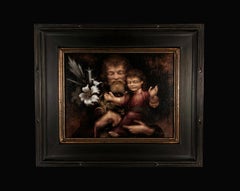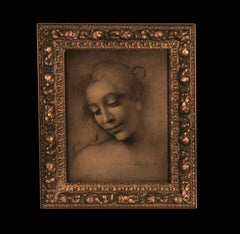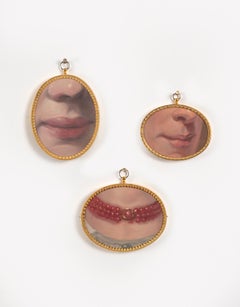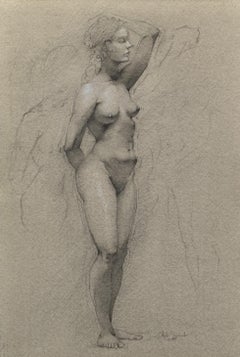Art
to
10
1
2
Overall Width
to
Overall Height
to
13
4
7
5
1
3
2
2
2
1
1
1
1
1
1
8
7
4
4
4
2
2
13
Paesaggio di Gamogna
Located in Mokena, IL
Paesaggio di Gamogna, 2024
Ink on Toned Paper, 4.5 x 3.75 inches
With a gentle pastoral view, “Paesaggio di Gamogna,” is a simple, heartfelt pen-and-ink rendering by Justas Varpuca...
Category
2010s Renaissance Landscape Drawings and Watercolors
Materials
Walnut, Ink, Handmade Paper
Sanctus Paulus
Located in Mokena, IL
Sanctus Paulus, 2024
Graphite and White Chalk on Toned Paper, 6 x 6.5 inches
A source of firm contemplation, Justas Varpucanskis’s drawing “Sanctus Paulus” is a resolute rendition ...
Category
2010s Renaissance Portrait Drawings and Watercolors
Materials
Chalk, Handmade Paper, Graphite
Sancte Ioseph
Located in Mokena, IL
Sancte Ioseph, 2023
Oil on Panel with Frame, 17.5 x 20.5 inches
With luminous depths, “Sancte Ioseph” presents an intimate portrayal of St. Joseph gently holding the Christ child, ...
Category
21st Century and Contemporary Contemporary Figurative Paintings
Materials
Oil
Eli
Located in Mokena, IL
Eli, 2020
Oil on Panel with Carved and Gilded Frame, 11.5 x 13.5 inches
An embodiment of Renaissance portraiture, Varpucanskis’s “Eli” is distinguished by its gentle charm and mat...
Category
21st Century and Contemporary Renaissance Portrait Paintings
Materials
Gold Leaf
$17,500
La Bella Attrice
Located in Mokena, IL
La Bella Attrice, 2018
Graphite and White Chalk on Toned Paper, 7.75 x 5.5 inches
Exemplifying the essence of Renaissance poise, La Bella Attrice showcases Justas Varpucanskis’s e...
Category
21st Century and Contemporary Renaissance Portrait Drawings and Watercolors
Materials
Chalk, Graphite
Ritratto con paesaggio
Located in Mokena, IL
Riratto con Paesaggio, 2019
Oil on Panel with Frame, 11 x 14 inches
A quiet and contemplative portrait painting, "Ritratto con Paesaggio", by Justas Varpucanskis, presents a sooth...
Category
21st Century and Contemporary Renaissance Portrait Paintings
Materials
Oil
Ritratto dell'uomo
Located in Mokena, IL
Riratto dell’uomo, 2019
Oil on Panel with Gilded Frame, 14 x 14 inches
Set against a penetrating black background, Justas Varpucanskis’s “Ritratto dell’uomo”’ emerges with a shrou...
Category
21st Century and Contemporary Contemporary Portrait Paintings
Materials
Oil
Coronation of Venus
Located in Mokena, IL
Coronation of Venus, 2021
Oil on Panel with 24k Gold Water-Gilded Frame, 114 x 78 inches
“Coronation of Venus,” an ornamentally enriching piece from the studio of Justas and Vilius...
Category
21st Century and Contemporary Renaissance Figurative Paintings
Materials
Gold Leaf
School of Stoics
Located in Mokena, IL
The School of Stoics brings the viewer into an airy evening discussion at an agora overlooking the Aegean Sea. Amidst the silent water and grained marble, a group of stoics debate logic, reason, and nature. Agreement and disagreement prevail in the noble gestures of their bodies. Soon you see an individual's gaze directed towards you, raising their hand, calling you to join the conversation.
Technical:
53” x 39”. Tempera on panel with 24k gold water-gilded frame. Painting and frame produced by artists Justas and Vilius Varpucanskis. This piece utilizes the "rules of craftsmanship" as outlined in Cenino Cennini's Il Libro dell'Arte. 21st century contemporary artwork that employs techniques, philosophy, and visual language of the Italian High Renaissance...
Category
21st Century and Contemporary Renaissance Figurative Paintings
Materials
Gold Leaf
Giardino di Rose
Located in Mokena, IL
Giardino di Rose, 2022
Ink on Toned Paper with Frame, 12.25 x 15.25 inches
Transporting the viewer to Florence’s sun-lit rose garden, Justas Varpucanskis...
Category
21st Century and Contemporary Contemporary Still-life Drawings and Water...
Materials
Ink, Handmade Paper
Ritratto di Noemi
Located in Mokena, IL
Ritratto di Noemi, 2019
Graphite and White Chalk on Toned Paper, 7 x 10 inches
“Ritratto di Noemi”, a captivating portrait, by artist Justas Varp...
Category
21st Century and Contemporary Contemporary Portrait Drawings and Waterco...
Materials
Chalk, Handmade Paper, Graphite
Pieta
Located in Mokena, IL
Pieta, 2019
Oil on Panel with Dutch Ripple Frame, 9 x 12 inches
A whispering portrayal of spiritual sorrow, Justas Varpucanskis’s “Pieta” present...
Category
21st Century and Contemporary Baroque Figurative Paintings
Materials
Oil
Our Lady of Mercy
Located in Mokena, IL
Our Lady of Mercy, 2021
Oil on Panel with Carved and Gilded Frame, 8 x 14 inches
A work of spiritual devotion, Justas Varpucanskis’s “Our Lady of...
Category
21st Century and Contemporary Renaissance Figurative Paintings
Materials
Gold Leaf
Related Items
Untitled (Man Reclining on Tile Floor)
By Mark Beard
Located in New York, NY
Graphite and conté crayon on paper
Signed and dated, l.r.
This artwork is offered by ClampArt, located in New York City.
Mark Beard, born in 1956 in Salt Lake City, now lives in Ne...
Category
1970s Realist Figurative Drawings and Watercolors
Materials
Paper, Graphite, Conté
They after Batoni and Hodges
By Derrick Guild
Located in London, GB
Dimensions variable: medium oval 7.5cm x 9.5cm; large oval 9cm x 11cm.
Derrick Guild is a Scottish artist whose paintings fragment Old Master works to explore the social fabric bene...
Category
2010s Contemporary Portrait Paintings
Materials
Linen, Oil
Oil Portrait of a Victorian Lady, c. 1850
Located in Chicago, IL
Painted in the 19th century, this exquisite miniature portrait wonderfully exemplifies realism in traditional oil painting. The small artwork is painted in the conventional portraiture style of the Old Masters, and achieves soft realism with fine brushwork and a subdued, neutral palette. The half length portrait depicts a fine Victorian woman dressed in all black with a delicate lace collar and bonnet. She wears a ruby broach...
Category
Mid-19th Century Old Masters More Art
Materials
Oil
Amate Bark Painting - Harvest Dance with Giant Rabbits
Located in Soquel, CA
Amate Bark Painting - Harvest Dance with Giant Rabbits
In this scene, people are carrying baskets to the village, through dense foliage. There are...
Category
Mid-20th Century Folk Art Figurative Drawings and Watercolors
Materials
Ink, Handmade Paper
I Used to Dream - Original Figurative Vibrant Mixed Media Painting on Canvas
Located in Los Angeles, CA
Rooted in introspection and emotional nuance, Xenia Gray’s figurative mixed media works capture the quiet tension between solitude and connection. Her paintings often depict the huma...
Category
2010s Contemporary Figurative Paintings
Materials
Canvas, Charcoal, Oil, Acrylic
'Ebren Ha Dor, Tremenus'. Framed contemporary landscape, rural sky blue nature
By Sophia Milligan
Located in Penzance, GB
'Ebren Ha Dor, Tremenus'. Contemporary landscape painting, Cornwall
Original Artwork. Framed ready to hang
_________________
The dancing light and rapidly changing skies, hung high a...
Category
2010s Naturalistic Landscape Drawings and Watercolors
Materials
Ink, Watercolor, Handmade Paper
$546 Sale Price
50% Off
H 17 in W 17 in D 3 in
Park City Spring - Framed Fantasy Landscape Painting on Handmade Paper
Located in Los Angeles, CA
Michaela Jean is an accomplished painter, devoted gardener, and mother from Southern California (USA). Her lifelong passion for art and nature began in childhood, inspired by her gra...
Category
2010s Impressionist Landscape Drawings and Watercolors
Materials
Oil Pastel, Ink, Acrylic, Watercolor, Handmade Paper
"Marilyn Monroe and ocean blue" ( semi-abstract oil painting of woman on paper)
Located in VÉNISSIEUX, FR
This artwork "Marilyn Monroe and ocean blue" is a dynamic exploration of the human form, using bold brushstrokes and vibrant colors to convey movement and emotion.
The piece featur...
Category
2010s Contemporary Figurative Paintings
Materials
Paper, Oil
$148 Sale Price
72% Off
H 11.7 in W 8.27 in D 0.04 in
Portrait of a Lady in White Chemise, Russet & Blue Drapery c.1695, Oil Painting
By Harman Verelst
Located in London, GB
This lavish portrait, painted circa 1695, is an exquisite example of the type of portrait in vogue during the last quarter of the seventeenth century. It is evident that the artist ...
Category
17th Century Old Masters Portrait Paintings
Materials
Canvas, Oil
$7,996
H 29.14 in W 24.41 in D 1.58 in
Amarillo By Morning - Desert Landscape Nature Painting on Handmade Paper
Located in Los Angeles, CA
Michaela Jean is an accomplished painter, devoted gardener, and mother from Southern California (USA). Her lifelong passion for art and nature began in childhood, inspired by her gra...
Category
2010s Impressionist Landscape Drawings and Watercolors
Materials
Ink, Acrylic, Watercolor, Color Pencil, Mixed Media, Handmade Paper
Portrait of a Lady in Green Dress & Pearl Jewellery c.1660 Painting John Wright
By John Michael Wright
Located in London, GB
In this exquisite work, painted around the time of the Great Fire of London in 1666, a beautiful young woman is wearing a green dress over a white chemise and a russet-coloured scarf...
Category
17th Century Old Masters Portrait Paintings
Materials
Canvas, Oil
$14,558
H 39.38 in W 33.47 in D 3.15 in
Portrait of Gentleman Blue & Cloak, Portrait of Lady, Fine Carved Gilded frames
Located in London, GB
Portrait of a Gentleman with Blue Cloak and Portrait of a Lady in Russet Dress c.1697
Thomas Murray (1663-1735)
These fascinating portraits are exquisite examples of portraiture in ...
Category
17th Century Old Masters Portrait Paintings
Materials
Oil, Canvas
$27,681
H 37.8 in W 33.47 in D 2.76 in
Previously Available Items
Florentine Figure Drawing
Located in Mokena, IL
Florentine Figure Drawing, 7x10 inches. Graphite and White Chalk on Toned Paper. Drawing by artist Justas Varpucanskis. This piece utilizes the "ru...
Category
21st Century and Contemporary Renaissance Nude Drawings and Watercolors
Materials
Chalk, Handmade Paper, Graphite
